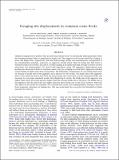Por favor, use este identificador para citar o enlazar a este item:
http://hdl.handle.net/10261/46357COMPARTIR / EXPORTAR:
 SHARE SHARE
 CORE
BASE CORE
BASE
|
|
| Visualizar otros formatos: MARC | Dublin Core | RDF | ORE | MODS | METS | DIDL | DATACITE | |

| Título: | Foraging Site Displacement in Common Crane Flocks |
Autor: | Bautista-Sopelana, Luis M. CSIC ORCID ; Alonso López, Juan C. CSIC ORCID ; Alonso López, Javier A. | Palabras clave: | Foraging Theory predicts Attack |
Fecha de publicación: | nov-1998 | Editor: | Elsevier | Citación: | Animal Behaviour, (56):1237-1243 | Resumen: | Optimal foraging theory predicts that an individual should resort to intraspecific kleptoparasitism when this foraging strategy helps to maximize its intake rate. Thus aggressor and victim should be foraging at lower and higher rates, respectively, than the flock average (intake rate maximization). Independent of the maximization principle, moreover, an aggressor should attack when its intake rate falls below a threshold critical for survival, and select a victim foraging at an intake rate high enough to ensure survival (starvation risk minimization). We tested both hypotheses using 324 aggressive displacements from feeding sites observed in flocks of common cranes, Grus grus, foraging on cereal fields. Aggressors attacked cranes feeding at higher rates than average birds. The immediate consequences of a successful attack were an increase in intake rate for the aggressor and a decrease for the victim. The intake rate of the aggressor prior to the attack was lower than both the mean intake rate of the flock and the minimum intake rate necessary to cover basic metabolic needs. After displacing its victim, the intake rate of the aggressor was higher than before the attack and also higher than the average intake rate of the flock. The intake rate of the aggressor after the attack was not higher than the mean intake rate of the flock, however, when the time spent on the attack was included. We conclude that cranes used a kleptoparasitic strategy to recover from temporary reductions in feeding rate. This was particularly the case below the threshold of intake necessary for survival. | Versión del editor: | http://dx.doi.org/10.1006/anbe.1998.0882 | URI: | http://hdl.handle.net/10261/46357 | DOI: | 10.1006/anbe.1998.0882 |
| Aparece en las colecciones: | (MNCN) Artículos |
Ficheros en este ítem:
| Fichero | Descripción | Tamaño | Formato | |
|---|---|---|---|---|
| Bautista AnimBehav56 p1237 1998.pdf | 195,94 kB | Adobe PDF |  Visualizar/Abrir |
CORE Recommender
SCOPUSTM
Citations
36
checked on 03-abr-2024
WEB OF SCIENCETM
Citations
35
checked on 24-feb-2024
Page view(s)
800
checked on 14-abr-2024
Download(s)
1.186
checked on 14-abr-2024
Google ScholarTM
Check
Altmetric
Altmetric
NOTA: Los ítems de Digital.CSIC están protegidos por copyright, con todos los derechos reservados, a menos que se indique lo contrario.
